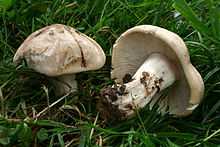Calocybe gambosa
| St. George's mushroom | |
|---|---|
 | |
| Scientific classification | |
| Kingdom: | Fungi |
| Division: | Basidiomycota |
| Class: | Agaricomycetes |
| Order: | Agaricales |
| Family: | Lyophyllaceae |
| Genus: | Calocybe |
| Species: | C. gambosa |
| Binomial name | |
| Calocybe gambosa (Fr.) Donk | |
| Calocybe gambosa | |
|---|---|
|
| |
| gills on hymenium | |
| cap is convex | |
| hymenium is free | |
| stipe is bare | |
| spore print is white | |
| ecology is mycorrhizal | |
| edibility: choice | |
Calocybe gambosa, commonly known as St. George's mushroom, is an edible mushroom that grows mainly in fields, grass verges and roadsides. Deriving its common name from when it first appears in the UK, namely on St George's Day (23 April). It appears in March in Italy, a warmer country, and is there known as marzolino, where it is very popular to eat.[1] It is also very popular in Northern Spain and Southern France, in the Basque Country region and its surroundings where it is called perretxiko and appears in April. In these regions it is usually eaten sautéed with egg or with bacon.
It is considered a delicacy, especially when fried in butter. It was previously considered a part of the large genus Tricholoma and is still seen as T. gambosum in older texts.
Taxonomy
Initially described as Agaricus gambosus by Elias Magnus Fries in 1821, with its specific epithet derived from a Latin term for club footed in relation to its bulky stem.[1] It was later named Tricholoma gambosum before being reclassified as Calocybe gambosa. In Germany it is known as Maipilz, where it fruits in May.[2] The genus name is derived from the Ancient Greek terms kalos "pretty", and cubos "head".[3] In Denmark it's called Vårmousseron, appearing in spring - early may [4]
Description
The cap measures from 5–15 cm in diameter and has a smooth texture and has ridges on it. The cap, stem and flesh can be from white-creamy coloured to bright yellow. The sinuate gills are white and crowded. The flesh is thick and soft and has a mealy or cucumber smell. The spore print is white to pinkish white. The stubby stem is bulky at the base.[1]
Care must be taken not to confuse it with the highly poisonous Inocybe erubescens, which grows in the same habitats. The latter has a more pungent fruity smell and bruises red. Entoloma sinuatum, also poisonous, has a rancid smell.[2]
Distribution and habitat
It is common in grasslands in Europe, often in areas rich in limestone. It is common on the Swedish islands Öland and Gotland, both situated in the Baltic sea. On the South Downs in southern England, it has formed huge fairy rings which appear to be several hundred years old.[5] It is found from April in the United Kingdom, and earlier in warmer countries.[1]
Edibility
The mushroom is best picked in dry weather. It can be eaten dry, pickled or even raw. It is imported in commercial quantities into Western Europe from Romania.[1]
References
- ↑ 1.0 1.1 1.2 1.3 1.4 Carluccio A (2003). The Complete Mushroom Book. Quadrille. p. 75. ISBN 1-84400-040-0.
- ↑ 2.0 2.1 Zeitlmayr L (1976). Wild Mushrooms:An Illustrated Handbook. Garden City Press, Hertfordshire. p. 70. ISBN 0-584-10324-7.
- ↑ Nilson S & Persson O (1977). Fungi of Northern Europe 2: Gill-Fungi. Penguin. p. 24. ISBN 0-14-063006-6.
- ↑ http://www.mycokey.org/result_textsearch.shtml?action=refresh&14945
- ↑ Ramsbottom J (1953). Mushrooms & Toadstools. Collins. p. 125. ISBN 1-870630-09-2.
External links
| Wikimedia Commons has media related to Calocybe gambosa. |